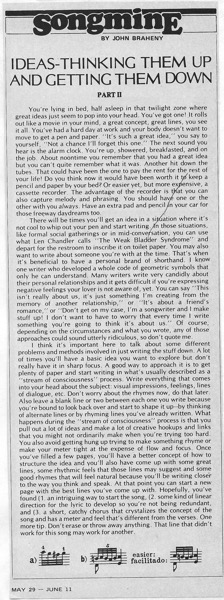A John Braheny Songmine column from the archives…

Accession Number: C000000137-031-002 Document/Digital File, “Songmine: Ideas – Thinking Them Up and Getting them Down Part 2″ by John Braheny”, OCR converted text under same Accession Number
(Digitally converted text. Some errors may occur)
IDEAS-THINKING THEM UP AND GETTING THEM DOWN
PART II
You’re lying in bed, half asleep in that twilight zone where great ideas just seem to pop into your head. You’ve got one! It rolls out like a movie in your mind, a great concept, great lines, you see it all. You’ve had a hard day at work and your body doesn’t want to move to get a pen and paper. “It’s such a great idea,” you say to yourself, “Not a chance I’ll forget this one.” The next sound you hear is the alarm clock. You’re up, showered, breakfasted, and on the job. About noontime you remember that you had a great idea but you can’t quite remember what it was. Another hit down the tubes. That could have been the one to pay the rent for the rest of your life! Do you think now it would have been worth it keep a pencil and paper by your bed? Or easier yet, but more ex ensive, a cassette recorder. The advantage of the recorder is t at you can also capture melody and phrasing. You should hav one or the other with you always. Have an extra pad and pencil n your car for those freeway daydreams too.
There will be times you’ll get an idea in a situation where it’s not cool to whip out your pen and start writing. n those situations, like formal social gatherings or in mid-conversation, you can use what Len Chandler calls “The Weak Bladder Syndrome” and depart for the restroom to inscribe it on toilet paper. You may also want to write about someone you’re with at the time. That’s when it’s beneficial to have a personal brand of shorthand. I know one writer who developed a whole code of geometric symbols that only he can understand. Many writers write very candidly about their personal relationships and it gets difficult if you’re expressing negative feelings your lover is not aware of, yet. You can say “This isn’t really about us, it’s just something I’m creating from the memory of another relationship,” or “It’s about a friend’s romance,’.’ or “Don’t get on my case, I’m a songwriter and I make stuff up! I don’t want to have to worry that every time I write something you’re going to think it’s about us.” Of course, depending on the circumstances and what you wrote, any of those approaches could sound utterly ridiculous, so don’t quote me.
I think it’s important here to talk about some different problems and methods involved in just writing the stuff down. A lot of times you’ll have a basic idea you want to explore but don’t really have it in sharp focus. A good way to approach it is to get plenty of paper and start writing in what’s usually described as a “stream of consciousness” process. Write everything that comes into your head about the subject: visual impressions, feelings, lines of dialogue, etc. Don’t worry about the rhymes now, do that later. Also leave a blank line or two between each one you write because you’re bound to look back over and start to shape it up–by thinking of alternate lines or by rhyming lines you’ve already written. What happens during the “stream of consciousness” process is that you pull out a lot of ideas and make a lot of creative hookups and links that you might not ordinarily make when you’re trying too hard. You also avoid getting hung up trying to make something rhyme or make your meter tight at the expense of flow and focus. Once you’ve filled a few pages, you’ll have a better concept of how to structure the idea and you’ll also have come up with some great lines, some rhythmic feels that those lines may suggest and some good rhymes that will feel natural because you’ll be writing closer to the way you think and speak. At that point you can start a new page with the best lines you’ve come up with. Hopefully, you’ve found (1. an intriguing way to start the song, (2. some kind of linear direction for the lyric to develop so you’re not being redundant, and (3. a short, catchy chorus that crystalizes the concept of the song and has a meter and feel that’s different from the verses. One more tip. Don’t erase or throw away anything. That line that didn’t work for this song may work for another.
See all previous entries in the Songmine Series
About Songmine and Music Connection Magazine:
John Braheny met Eric Bettelli and Michael Dolan right before they were going to publish Music Connection magazine. Eric and Michael wanted to get their publication out to as many songwriters as they could. They had already heard of the LA Songwriters Showcase, and of John and his partner, Len Chandler. John’s goal was to advertise the schedule of guest speakers and performers at the weekly Showcase… so they made a deal.
They published John’s Songmine column (he had never before written a magazine article!) in their very first edition, in November 1977. Trading out the column for advertising, this arrangement continued for many years. Plus, Eric and Michael came to the Showcase each week and distributed free copies to the songwriters!
Those articles became so popular that (book agent and editor) Ronny Schiff offered John’s articles to F&W Media, where they became the backbone of John’s textbook, The Craft and Business of Songwriting. As a follow-up, Dan Kimpel (author, songwriter, teacher), who had also worked at LASS, took on the Songwriting column at Music Connection magazine which continues to this day! You can subscribe to get either hard copies or online.
No comments yet.